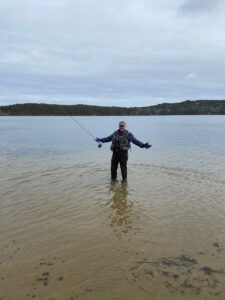You would think that after 50 years of obsessive globe-trotting in search of new and better places to fish, the last place I’d find would be a pond in my own back yard. Gull Pond will always occupy a place in my heart as the pond where I learned to fly-fish — even though it was inhabited only by trout stocked by the state every spring.
While other ponds are cherished for other fish — Snow Pond in Truro has its smallmouth bass, and at Williams and Higgins ponds in Wellfleet it’s all about the pickerel — lovely, clear Gull Pond is mainly known as one of the best local trout ponds.

My appreciation of Gull Pond deepened last year because of an encounter with an old fishing pal there. Lowell Brundage and I had shared many a morning on the chilly water back when we were both learning how to work our fly rods. In the 1970s, our fly of choice on Gull Pond was the black wooly bugger — a long, fuzzy fly pattern that resembled absolutely nothing in the natural world. It didn’t look like any bug we had ever seen in the pond nor like any minnow. Maybe, we thought, it resembled a fat leech or simply was attractive to trout as an amalgam of various creatures.
When I ran into Lowell at the pond last spring, he told me that his go-to fly was now a small beaded nymph pattern called Copper John, typically used only for fishing in fast-moving streams. The nymph, about a tenth the size of a wooly bugger, had that day attracted a couple of very large holdover fish.
I had never even considered using a tiny trout stream fly in the still, deep waters of Gull Pond. Lowell handed me a couple, which I greedily attached to my line. Then I waded into the pond and right away felt the satisfying pull of a soon-to-be-released rainbow trout.
Not only had Lowell’s knowledge and generosity changed how I fished in this spot, but over the next week or so it gave me a new understanding of the thriving, diverse life the pond supported.
That first day, I caught both a rainbow and a brown trout. Two days later, at the same spot, I hooked a beautiful brook trout with its bright red, yellow, and blue spots. That same day, I also hooked a big, heavy fish that fought me doggedly for more than five minutes before I brought it to the net. Until it reached my rod tip, I had no idea what it was; it did not fight with the quick runs and splashy leaps common to trout. I had caught, for the first time in all my years on Gull Pond, a fat sucker fish that might have tipped the scale at five pounds. It was not the prettiest or sportiest of fish but, after a long winter, was still a thrill to catch.
A few days later, fishing the flats on the town parking lot side of the pond, I hooked another big fish, but this time I knew instantly what it was. The flats in springtime are full of nesting smallmouth bass, an aggressive, hard-fighting, and high-jumping fish. I quickly released the bass to return to her nest, surprised not by the species but by the fact that a smallmouth bass would hit as tiny a fly as I was using.

I had yet another pleasant surprise later that day. I was slowly twitching my line through the water when I hooked another fish, smaller than any of the trout I had caught, but still a feisty little silvery fish that jumped and splashed as I brought it to the net. It was a white perch, an anadromous fish — one that migrates from salt water to fresh water in the spring to spawn. In my youth I had often caught white perch off the Wellfleet town pier and the Herring River dike, using tiny silverside minnows as bait. But I had never caught or even seen one in Gull Pond.
I surmised that the perch must accompany the herring as they make their way upstream in April, and as I pulled in what I thought would be another white perch, there was some evidence that could be the case: the fish was a river herring. Over the next few days, I hooked and released dozens of herring and perch, whose tiny mouths would never have accommodated a much larger fly or lure.
It was fun to catch such a broad panoply of fish in a place that had in the past seemed to be populated only with stocked trout, a piscatorial version of a washashore, ladled into the pond from a Dept. of Fish and Game tanker. While trout may be sexier than suckers, white perch, and herring, there’s something deeply satisfying about catching fish in the very place where they were born and bred.



